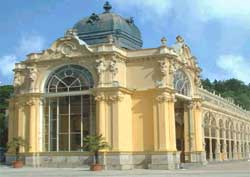Marienbad
 Why
Marienbad
is special
Why
Marienbad
is specialFrom the early 1800s through the late 1920s, Marienbad was one of the world's most exclusive thermal spring spas. It attracted royalty and aristocrats plus titans of music and literature. Although Marienbad gradually fell into disrepair in the ensuing years, many of its pastel-hued Baroque buildings have been restored in the last couple of decades.
Marienbad tips and insights
Setting
Marienbad sits in a pleasant valley surrounded on three sides by pine forested hills. Several dozen mineral springs dot the area. They are warmed by subterranean volcanic activity.
Spas
The local mineral spring waters help cure a long list of diseases (say the spa operators). Some charming old fashioned spa hotels are still around (Nove Lazne is the most famous). Spa treatments are available, including thermal, mud, and carbon dioxide gas baths.
Colonnade
Visitors come to the main colonnade (see photo) to drink the mineral water out of a small, spouted porcelain cup used exclusively for that liquid.
How to pronounce
Marienbad: mehr'-ee-ahn'-bahd
When to come
Spring through Fall is the best visiting time.
Movie location
The acclaimed 1961 French movie "Last Year in Marienbad" helped spread the town's fame around the world.
Unrequited love
Two centuries ago, the world renowned German writer Goethe (then 72) unsuccessfully courted a teenage baroness in Marienbad.
Name
Although Marianske Lazne is its Czech name, this spa town is better known globally by its German name, Marienbad.
Nearest major city
Marienbad is 150 kilometers (90 miles) west of Prague, the capital of the Czech Republic. Train service exists.


